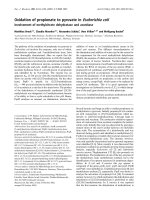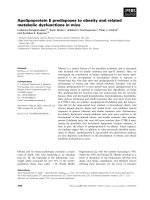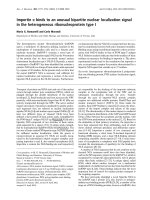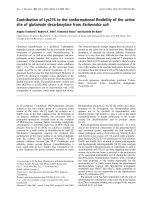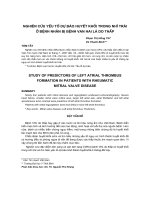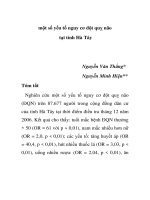Báo cáo y học: "Skin Test Reactivity to Indoor Allergens Correlates with Asthma Severity in Jeddah, Saudi Arabia" docx
Bạn đang xem bản rút gọn của tài liệu. Xem và tải ngay bản đầy đủ của tài liệu tại đây (98.25 KB, 9 trang )
11
Asthmatic airways are characterized by an
immunologic chronic inflammation that has been
documented to occur after exposure to an aller-
gen.
1,2
Several studies have suggested a correlation
between allergen exposure and the prevalence of
asthma.
3–5
In sensitized individuals, exposure to air-
borne allergens is a risk factor for asthma exac-
erbations, the persistence of asthma symptoms, and
significant changes in pulmonary function.
6–8
Worldwide, the documented increase in the
prevalence of asthma has been almost entirely
an increase in that of perennial asthma, and a
Original Article
Skin Test Reactivity to Indoor Allergens
Correlates with Asthma Severity
in Jeddah, Saudi Arabia
Emad A. Koshak, MD, FRCPSC
Abstract
Background: There is increased emphasis on the role of indoor allergens in asthma.
Objective: To examine the spectrum of skin test reactivity (sensitization) to indoor allergens and its cor-
relation with asthma severity in Jeddah, Saudi Arabia.
Methods: Asthmatic patients referred to the allergy clinic at King Abdulaziz University Hospital (KAUH)
in Jeddah were studied.Measures of clinical severity were adopted from national and international asthma
guidelines.The degree of sensitization was assessed by the wheal size (positive ≥ 3 mm) from standard
skin-prick tests for the following common indoor inhalant allergens:house dust mites
(Dermatophagoides
pteronyssinus [Dp] and Dermatophagoides farinae [Df]), cat, and cockroach.
Results: Skin test results from 113 of 151 (74.8%) asthmatic patients were positive for one or more aller-
gens. The patients’ ages ranged between 9 and 63 years (mean, 30 ± 13 years), and females consti-
tuted 65.5%.The predominant asthma severity level was moderate persistent (55.8%), followed by mild
persistent (33.6%). The prevalences of sensitization to indoor allergens were as follows: Dp, 87%
(3–25 mm [mean, 7 mm]); Df, 84% (3–20 mm [mean, 7 mm]); cat, 44% (3–15 mm [mean, 6 mm]); and
cockroach, 33% (3–12 mm [mean, 4 mm]). Higher asthma severity levels were significantly correlated
with the number of allergens with positive sensitization (R = 0.3, p < .001) and with the degree of sen-
sitization to house dust mites (Dp [degrees of freedom {df} = 16, p < .001] and Df [df = 17, p < .01]) but
not to cat (df = 10, p < .24) or cockroach (df = 8, p < .36).
Conclusions: Immunoglobulin E–mediated skin test reactivity to indoor allergens, particularly to house
dust mites, was common in asthmatic patients from Jeddah at KAUH.Increased sensitization was asso-
ciated with higher levels of asthma severity, which is compatible with the literature.This emphasizes the
importance of identifying sensitization to relevant indoor allergens in the clinical evaluation of asthmatic
persons.
E.A. K
oshak—Associa
te Pr
of
essor and Consultant in
Inter
nal Medicine, Allergy, Asthma, and Clinical
Immunology, Department of Internal Medicine, Faculty of
Medicine
,
King
Abdulaziz Uni
v
ersity Hospital, Jeddah,
Saudi
Arabia
Cor
respondence to: Dr. Emad A. Koshak, Department of
Inter
nal Medicine
,
King
Abdulaziz Uni
v
er
sity Hospital,
P
.O
. Bo
x 80215,
J
eddah, 21589, Kingdom of Saudi Arabia
DOI 10.2310/7480.2006.00002
12 Allergy, Asthma, and Clinical Immunology / Volume 2, Number 1, Spring 2006
large proportion of such patients are allergic to
allergens that are found all year round in homes.
9,10
This has led to increased interest in the immuno-
logic role of allergenic substances that accumu-
late indoors. Indoor allergens today have increased
in developed countries where homes have been
insulated for energy efficiency, carpeted, heated,
cooled, and humidified—changes that have also
made homes an ideal habitat for the generators of
indoor allergens.
11,12
Globally, the most abundant indoor allergens
include those derived from house dust mites
(HDMs), cats, and cockroaches.
12,13
The principal
HDM species are the pyroglyphid mites (
Der-
matophagoides pteronyssinus
[Dp], Der-
matophagoides farinae
[Df], and others), which
usually account for 90% of mite species in house
dust in temperate regions.
9,14
According to some
local studies, similar allergens have been isolated
from the homes of asthmatic persons living in
different regions of Saudi Arabia.
15
Recent pr
o
g
r
ess in the f
ields of allergy and
imm
unolo
g
y ha
v
e promoted extensive studies on
the identif
ica
tion of sensitiza
tion to indoor aller
-
g
ens. In vi
v
o and in vitr
o aller
g
y tests ar
e consid
-
er
ed v
alua
b
le tools f
or e
xplor
ing the pr
esence of
an imm
uno
glob
ulin E (IgE)–media
ted imm
une
r
esponse in a
topic disor
der
s suc
h as br
onc
hial
asthma,
and their r
esults ar
e a r
ef
lection of sensi
-
tiza
tion to the g
i
v
en aller
g
en.
16–18
Pr
e
vious in
v
es
-
tig
a
tor
s demonstr
a
ted a dir
ect r
elationship between
positi
v
e aller
g
y skin test r
eactions or sensitiza
tion
to inhalant indoor aller
g
ens and the incr
ease in
the se
v
er
ity of asthma.
19,20
Ho
w
e
v
er
,
no stud
y has
f
ocused pr
imar
il
y on the c
linical se
verity of asthma
(assessed b
y inter
na
tional and na
tional asthma
management guidelines) in relation to common
indoor allergens detected in Saudi Arabia.
Hence, this study aimed to explore the spec-
trum of IgE-mediated skin test reactivity or sen-
sitization to common indoor inhalant allergens
among asthmatic patients seen at King Abdu-
laziz University Hospital (KAUH) in Jeddah, the
second-largest city in Saudi Arabia. This work
focuses on the hypothesis that skin test reactivity
to indoor allergens may have a relationship with
higher levels of clinical severity of asthma.
Methods
This was a cross-sectional study on 151 patients
with a primary diagnosis of bronchial asthma.
They were sequentially selected from patients
examined at the allergy clinic of KAUH from Jan-
uary 1997 to December 1999. Only patients who
were living in the city of Jeddah were included in
the study. Jeddah is a coastal city located in the
western region of the Kingdom of Saudi Arabia on
the Red Sea, and high humidity characterizes its
weather, particularly in the summer season. The
criteria for the diagnosis and assessment of the clin-
ical severity of each asthmatic patient were day-
time symptoms, nocturnal symptoms, and mean
peak expiratory flow at the clinic visit (Table 1).
These criteria were adopted from the National
Asthma Education Prevention Program in the
United States and the Saudi national protocol for
the management of asthma.
21,22
The presence of one
of the features of severity is sufficient to place a
patient in that severity category. Each asthmatic
patient was assigned to the most severe grade in
which any of their features occurred.
Table 1 Criteria Used for Categorizing the Clinical Severity of Asthmatic Patients
Severity Level Day Symptoms Night Symptoms PEF
Mild intermittent ≤ 2 times/week ≤ 2 times/month ≥ 80%
Mild persistent > 2 times/week but < 1 time/day > 2 times/month ≥ 80%
Moder
ate persistent Daily > 1 time/week > 60 to < 80%
Severe persistent Continuous Frequent ≤ 60%
PEF = peak e
xpiratory flow.
Indoor Allergens and Asthma Severity — Koshak 13
Demographic data, documented asthma sever-
ity level assessments, and the results of skin-prick
tests (SPTs) for common inhalant allergens were
extracted from the records of the patients. The
assessment of the level of asthma severity was
carried out and documented in each patient’s chart
before the SPT was performed. The following
patients were excluded from the study:
• Smokers (to rule out chronic obstructive
airway disease)
• Patients who were pregnant or taking
-blockers (for safety reasons)
• Patients taking antihistamines or taking
long-term oral corticosteroids for more than
1 week (because of their negative effect on
SPT results)
Skin test reactivity (sensitization) was deter-
mined by reviewing the results of reactions to a
standard SPT after 15 minutes. Verbal consent
w
as obtained fr
om candida
tes pr
ior to skin-prick
testing
.
T
he panel of indoor aller
gen extracts
a
ppr
opriate for the SPTs was obtained from Greer
La
bor
atories in the United States. The indoor
aller
g
ens used were the two common species of
HDM (
Dp and Df) and ca
t and cockroach extracts.
T
he cockroach extract contained a 1:10 (weight per
v
olume) mixture of two common species,
Bla
ttella
g
ermanica
(Ger
man cockroach) and
P
eriplaneta
amer
icana
(Amer
ican cockroach). Extracts of the
HDMs (
Dp and Df) and ca
t hair exist in concen-
tr
ations of 10,000 allergen units per millilitre.
After sterilization of the forearm with propyl
alcohol, single drops of each allergen extract were
applied, 2 cm apart. A skin-prick test was per-
formed within the allergen drops on the skin with
a 26-gauge needle. Additionally, a drop of hista-
mine phosphate (at a concentration of 2.7 mg/mL)
and a drop of the diluent were used as a positive
control and a negative control, respectively. A
wheal ≥ 5 mm in size in reaction to histamine
was considered adequate for the competency of the
test. A wheal ≥ 3 mm in diameter (more than the
negative control) was considered a positive test
result for sensitization to that peculiar allergen. The
size of wheal for each indoor allergen was recorded
and was used as a reflection of the degree of skin
test reactivity (sensitization).
The degree of skin test reactivity for each
case was classified, according to the diameter of
its wheal, as mild sensitization (3–5 mm), mod-
erate sensitization (6–10 mm), or severe sensiti-
zation (≥ 11 mm). Furthermore, the number of
indoor allergens yielding a positive reaction was
recorded for each case.
The data were entered into a personal com-
puter. Frequency tables, correlation analysis by
P
ear
son’
s test,
and analysis of variance were per-
f
or
med with
SPSS v
er
sion 11
sta
tistical softw
ar
e
.
Results
Of 151 asthmatic individuals living in Jeddah,
113 had positive skin test reactions to one or more
indoor allergens, accounting for 74.8% of the
studied group. The ages of the patients who had
positive skin test results ranged between 9 and 63
years (mean, 30 ± 13 standard deviations [SD]),
and 74 (65.5%) were female. The predominant lev-
els of asthma severity were moderate persistent (63
cases [55.8%]) and mild persistent (38 cases
[33.6%]) (Table 2).
Table 2 Frequency of Asthma Clinical Severity Levels
Severity Level No. of Patients % of Patients Cumulative %
Mild intermittent 8 7.1 7.1
Mild persistent 38 33.6 40.7
Moder
ate persistent 63 55.8 96.5
Severe persistent 4 3.5 100.0
Total 113 100.0 —
The prevalence of positive skin reactivity and
wheal size was highest for both HDMs: 98 cases
(87%) for
Dp and 95 cases (84%) for Df (Table 3).
Sensitization to more than one allergen, and par-
ticularly to two and three different allergens, was
common (Table 4).
The frequency of asthma cases in each cate-
gory of sensitization degree is shown in Figure 1.
There was a correlation between sensitization to
the two species of HDM (
Df and Dp, p < .001),
which represents a known cross-reactivity between
them.
Statistically, the increasing levels of clinical
severity in the asthmatic patients under study were
significantly correlated to the number of indoor
allergens yielding positive skin test reactivity (sen-
sitization) (R = 0.3,
p < .001) and to the degree of
skin test reactivity (ie, wheal size) to
Dp (df = 16,
p < .001) and Df (df = 17, p < .01) but did not reach
statistical significance in the cases of cat (
df = 10,
p < .24) and cockroach (df = 8, p < .36) allergens.
The relation between the severity of asthma
and the degree of skin test reactivity to the different
indoor allergens is shown in Figure 2. The linear
relation between the severity of asthma and the
mean degree of skin test reactivity is illustrated in
Figure 3. Figure 4 shows that higher levels of
asthma severity were associated with higher num-
bers of sensitization to indoor allergens.
Discussion
Our predominantly sedentary indoor lifestyle has
been identified as one of the probable causes for
increases in the prevalence of asthma. This indoor
lifestyle may have led to either an increased expo-
sure to allergens or an increase in factors that enhance
the lungs’ response to foreign proteins.
9
Clearly,
exposure to allergens can provoke acute asthma
attacks as well as chronic allergic symptoms.
10
In this study, positive skin test reactions to
common indoor allergens were seen in up to three-
quarters of the enrolled asthmatic patients who
were referred to the allergy clinic. Although such
a high rate of sensitization is compatible with
some international figures, selection bias must be
considered.
9,23
The majority of patients seen at
the aller
g
y clinic have moderate persistent asthma
w
her
eas most asthma
tic per
sons in the g
eneral
popula
tion ha
v
e mild asthma. Doctor
s r
efer patients
w
hom the
y suspect to ha
v
e aller
gies to the allergy
c
linic
,
or pa
tients r
equest allergy assessment if
the
y suspect themselv
es to ha
v
e an allergy. In
14 Allergy, Asthma, and Clinical Immunology / Volume 2, Number 1, Spring 2006
Table 3 Prevalence of Positive Skin Reactivity to the Different Indoor Allergens
Allergen No. of Patients % of Patients Wheal Diameter (mm) Mean ± SD
HDM (Dp) 98 87 3–25 7 ±4
HDM (Df) 95 84 3–20 7 ±4
Ca
t 50 44 3–15 6 ±2
Cockroach 38 33 3–12 4 ±2
Df = Der
matophagoides farinae; Dp = Dermatophagoides pteronyssinus
; HDM = house dust mite
.
Table 4 Number of Allergens Yielding Positive Skin Test Reactivity (Sensitization)
No. of Patients % of Patients Cumulative %
Sensitization to 1 allergen 17 15.0 15.0
Sensitization to 2 allergens 39 34.5 49.6
Sensitization to 3 allergens 40 35.4 85.0
Sensitization to 4 allergens 17 15.0 100.0
Total 113 100.0 —
Indoor Allergens and Asthma Severity — Koshak 15
Figure 1 The degree of skin test reactivity (sensitiza-
tion) to the indoor allergens studied. Wheal size was
used as the measure of the degree of skin test reactiv-
ity (0–2 mm, negative; 3–5 mm, mild; 6–10 mm, mod-
erate; > 10 mm, severe).
Figure 3 Mean skin test reactivity (wheal size in mil-
limetres) to indoor allergens studied.
Figure 4 Number of allergens yielding sensitization,
plotted against asthma severity.
Figure 2 Box plot of skin test reactivity to the differ-
ent indoor allergens studied.
vie
w of selection bias, the prevalence of sensiti-
zation in the general asthmatic population in Jed-
dah is most likely lower and needs investigation.
Sensitization to the two species of HDM was
the predominant indoor allergen sensitization in
more than 80% of the asthmatic patients. This
pattern of sensitization is expected in a humid
coastal city such as Jeddah. Conditions for mite
growth are a temperature between 22° and 26°C
and a relative humidity > 55%.
Dp is the dominant
mite in constantly damp climates;
Df survives
better in somewhat drier climates. Modern houses
are characterized by wall-to-wall carpeting, box
mattresses, and optimal temperatures for the
growth of HDMs. Worldwide, there is evidence to
suggest that HDMs are the most common indoor
allergens associated with asthma.
8,9
Alferah and colleagues conducted a study to
analyze HDM content in samples collected from
asthmatic patients’ indoor environments in four
regions of Saudi Arabia.
15
The humid western
region showed a high concentration of HDM (par-
ticularly more
Der f I). Variations in both quali-
tative and quantitative assessments of HDMs may
be attributed to variations in geography and climate,
particularly humidity. SPT results with HDM
allergens also revealed a high positivity rate, con-
sistent with the concentration of HDMs in the
region.
15
This shows the possible influence of
mites in patients’allergic manifestations, which are
not only common but are also increasing in parts
of the country. Airborne allergens were identified
as risk factors for asthma and other allergic dis-
eases in other Arabian Gulf countries.
24
In this study, sensitization to cat allergen was
evident in nearly half of the patients with positive
skin test results, and sensitization to cockroach
allergen was evident in one-third of them. Cat
allergen is responsible for the rapid onset of res-
piratory symptoms in cat-sensitized persons enter-
ing an indoor environment that contains a cat and
may constitute a relevant risk factor for asthma
exacerbations.
25,26
Additionally, public places and
homes without a cat may contain sufficient aller-
genic protein to induce clinical symptoms in highly
sensitized persons.
27,28
In some locations, sensiti-
za
tion to coc
kroach allergen may be as common
as sensitiza
tion to domestic mite allergens and
can have a greater effect on asthma morbidity.
29–31
Some indoor fungi (moulds) are an estab-
lished risk factor for asthma in various popula-
tions.
6,32
Future studies on the impact of other
indoor allergens, such as moulds, on asthma in
Saudi Arabia are needed.
This study demonstrated a correlation between
the degree of IgE-mediated skin test reactivity to
indoor allergens, particularly HDMs, and higher
levels of clinical severity of asthma. The correla-
tion found was low, and it was highly dependent
on the four subjects in the severe persistent cate-
gory. In other regions of the world, such a corre-
lation has been recognized by several investiga-
tors.
20,33,34
The strength of the IgE antibody
response to HDMs in humid climates could con-
tribute to the increased prevalence and severity of
asthma.
30,34
Recent asthma guidelines have established
that great attention should be given to measures
to prevent the symptoms of this chronic, lifelong,
and incurable disease.
35
Some measures for the pre-
vention of asthma symptoms involve the avoidance
of allergens and nonspecific triggers when asthma
is established. Several studies have documented an
improvement in asthma after exposure to the aller-
gen ceases.
36–38
Thus, indoor environmental con-
trol measures to reduce exposure to allergens
might be important, but complete control is diffi-
cult to achieve, and there is conflicting evidence
about whether such control measures are effective
at reducing asthma symptoms.
39,40
Effective con-
trol strategies should be (1) tailored to individual
allergens, (2) flexible for suiting individual needs,
and (3) cost effective.
35,41
HDMs are especially important in humid areas
in Saudi Arabia, such as the cities of Jeddah and
Dammam.
15
According to asthma management
guidelines, measures that significantly reduce
exposure to mites must be an integral part of
asthma management for asthmatic persons who
have been sensitized to clinically relevant aller-
gens.
35,42
Environmental controls should be rein-
forced when asthma is poorly controlled or requires
significant medication or whenever there is a sug-
g
estion tha
t exposure to mites is playing a role.
35,42
T
he most ef
fective and probably most important
16 Allergy, Asthma, and Clinical Immunology / Volume 2, Number 1, Spring 2006
avoidance measure is to use mattress, pillow, and
duvet covers that are impermeable to mite aller-
gens (evidence level B).
43–45
Conclusion
This work demonstrated that three-quarters of asth-
matic persons living in Jeddah, Saudi Arabia, who
were referred to the allergy clinic at King Abdulaziz
University Hospital were sensitized to common
indoor inhalant allergens. Additionally, there was
a clear association between the degree of skin test
reactivity to common indoor inhalant allergens
and higher levels of clinical severity of bronchial
asthma. Based on this, asthmatics should be offered
effective education about the importance of explor-
ing their sensitization to relevant environmental
allergens. Subsequently, for better symptom con-
trol, health care workers must be encouraged to
apply individualized educational strategies for the
avoidance of allergens that are clinically relevant
for their particular asthmatic patients. Eventually,
this will be of significant help in the overall man-
agement of asthma symptoms.
Acknowledgement
This research was extrapolated from an unpub-
lished study on the pattern of sensitization to com-
mon inhalant allergens in patients at King
Abdulaziz University Hospital and was conducted
during a year of sabbatical leave provided by King
Abdulaziz University.
References
1.
Amer
ican
T
hor
acic Society. Progress of the inter-
face of inflammation and asthma. Am J Respir
Cr
it Care Med 1995;152:385–9.
2. Robinson D. Allergen-induced airways inflam-
mation in asthma. Monaldi Arch Chest Dis
1996;51:469–74.
3. Sporik R,Holgate ST, Platts-Mills TA, Cogswell
JJ. Exposure to house-dust mite allergen (Der p
I) and the development of asthma in childhood.
A prospective study. N Engl J Med 1990;
323:502–7.
4. Platts-Mills TA. Role of allergens in asthma and
airw
ay hyperresponsiveness: relevance to
immunotherapy and allergen avoidance. In: Kaliner
MA,
Persson CG, editors. Asthma: its pathology
and treatment. New York: Marcel Dekker; 1991.
5. Newman-Taylor A. Environmental determinants
of asthma. Lancet 1995;345:296–9.
6. O’Hollaren MT,Yunginger JW, Offord KP, et al.
Exposure to an aeroallergen as a possible pre-
cipitating factor in respiratory arrest in young
patients with asthma. N Engl J Med 1991;
324:359–63.
7. Djukanovic R, Feather I, Gratziou C, et al. Effect
of natural allergen exposure during the grass
pollen season on airways inflammatory cells and
asthma symptoms. Thorax 1996;51:575–81.
8. Nelson HS. The importance of allergens in the
development of asthma and the persistence of
symptoms. J Allergy Clin Immunol 2000;
105:S628–32.
9. Platts-Mills TTA,Vervloet D, Thomas WR, et al.
Indoor allergens and asthma: report of the Third
International Workshop. J Allergy Clin Immunol
1997;100(6 Pt 1):S2–24.
10. Gold DR. Environmental tobacco smoke, indoor
allergens, and childhood asthma. Environ Health
Perspect 2000;108 Suppl 4:643–51.
11. Harrison PT. Creature comforts—living with
mites and moulds. Clin Exp Allergy 1999;
29:148–9.
12. Hirsch T, Hering M, Burkner K, et al. House-
dust-mite allergen concentrations (Der f 1) and
mold spores in apartment bedrooms before and
after installation of insulated windows and cen-
tral heating systems. Allergy 2000;55:79–83.
13. Sporik R, Ingram JM, Price W, et al. Association
of asthma with serum IgE and skin test reactiv-
ity to allergens among children living at high
altitude. Tickling the dragon’s breath. Am J Respir
Crit Care Med 1995;151:1388–92.
14.
Pla
tts-Mills
T
A,
Thomas WR, Aalberse RC, et
al. Dust mite allergens and asthma: report of a
second inter
national workshop. J Allergy Clin
Imm
unol 1992;89:1046–60.
15. Al-Frayh AS, Hasnain SM, Gad-El-Rab MO, et
al. House dust mite allergens in Saudi Arabia:
regional variations and immune response. Ann
Saudi Med 1997;17:156–160.
Indoor Allergens and Asthma Severity —
Koshak 17
16. Burrows B, Martinez FD, Halonen M, et al.
Association of asthma with serum IgE levels and
skin test r
eactivity to allergens. N Engl J Med
1989;320:271–7.
17. Eriksson NE. Diagnosis of IgE mediated allergy
in c
linical practice. Allergol Immunopathol
(Madr) 1994;22:139–51.
18. Gordon BR. Allergy skin tests for inhalants and
foods. Comparison of methods in common use.
Otolaryngol Clin North Am 1998;31:35–53.
19. Langley SJ, Goldthorpe S, Craven M, et al.
Exposure and sensitization to indoor allergens:
association with lung function, bronchial reac-
tivity, and exhaled nitric oxide measures in
asthma. J Allergy Clin Immunol 2003;112:362–8.
20. Sarpong SB, Karrison T. Skin test reactivity to
indoor allergens as a marker of asthma severity
in children with asthma. Ann Allergy Asthma
Immunol 1998;80:303–8.
21. Al-Rayes H, Mobaireek K, Shimemreri A,
Majeed S, editors. The national protocol for the
management of asthma. 2nd ed. Saudi Arabia:
Ministry of Health; 1997.
22. National Asthma Education Prevention Program
(NAEPP). Expert Panel Report 2. National
Institutes of Health (US); 1997 Mar. Publication
No.: 97-3659.
23. Gerritsen J, Koeter GH, deMonchy JGR. Allergy
in subjects with asthma from childhood to adult-
hood. J Allergy Clin Immunol 1990;85:116–25.
24. Bener A, Safa W,Abdulhalik S,Lestringant GG.
An analysis of skin prick test reactions in asth-
matics in a hot climate and desert environment.
Allerg Immunol (Paris) 2002;34:281–6.
25.
Custovic A, Simpson A, Woodcock A. Importance
of indoor allergens in the induction of allergy
and elicitation of allergic disease. Allergy
1998;53:115–20.
26. Liccardi G, Cazzola M, D’Amato M, D’Amato
G. Pets and cockroaches: two increasing causes
of respiratory allergy in indoor environments.
Characteristics of airways sensitization and pre-
v
ention str
a
tegies. Respir Med 2000;94:1109–18.
27. Partti-Pellinen K, Marttila O, Makinen-Kiljunen
S, Haahtela T. Occurrence of dog, cat, and mite
allergens in public transport vehicles. Allergy
2000;55:65–8.
28. Simpson A, Custovic A. Pets and the develop-
ment of allergic sensitization. Curr Allergy
Asthma Rep 2005;5:212–20.
29. Rosenstreich D, Eggleston P, Kattan M, et al.
The role of cockroach allergy and exposure to
cockroach allergen in causing morbidity among
inner-city children with asthma. N Engl J Med
1997;336:1356–63.
30. Wood RA. House dust mite and cockroach expo-
sure: risk factors for asthma. J Aerosol Med
2004;17:165–8.
31. Gruchalla R, Pongracic J, Plaut M, et al. Inner
City Asthma Study: relationships among sen-
sitivity, allergen exposure, and asthma
morbidity. J Allergy Clin Immunol 2005;
115:478–85.
32. Halonen M, Stern DA, Wright AL, et al.
Alternaria as a major allergen for asthma in chil-
dren raised in a desert environment. Am J Respir
Crit Care Med 1997;155:1356–61.
33. Kupczyk M, Kuprys I, Gorski P, Kuna P. Aspirin
intolerance and allergy to house dust mites:
important factors associated with development
of severe asthma. Ann Allergy Asthma Immunol
2004;92:453–8.
34. Erwin EA, Wickens K, Custis NJ, et al. Cat and
dust mite sensitivity and tolerance in relation to
wheezing among children raised with high expo-
sure to both allergens. J Allergy Clin Immunol
2005;115:74–9.
35. Global strategy for asthma management and pre-
vention. Management segment (chapter 7).
Washington (DC): National Institutes of Health
(US); 1995 Jan. (2004 Update). NIH Publication
No: 02-3659.
36. von Mutius E, Martinez FD, Fritzsch C, et al.
Prevalence of asthma and atopy in two areas of
West and East Germany. Am J Respir Crit Care
Med 1994;149:358–64.
37. Leung R, Ho P. Asthma, allergy, and atopy in
three South-east Asian populations. Thorax
1994;49:1205–10.
38. Becker AB. Primary prevention of allergy and
asthma is possible. Clin Rev Allergy Immunol
2005;28:5–16.
39. Gotzsche PC, Hammarquist C, Burr M. House
dust mite contr
ol measur
es in the mana
gement
of asthma: meta-analysis. BMJ 1998;317:
1105–10.
40. Gotzsche PC, Johansen HK, Hammarquist C,
Burr ML. House dust mite control measures for
asthma (Coc
hr
ane Re
view). Cochrane Database
Syst Rev 2001;2.
18
Allergy, Asthma, and Clinical Immunology / Volume 2, Number 1, Spring 2006
41. Custovic A, Simpson A, Chapman MD,
W
oodcock A. Allergen avoidance in the treat-
ment of asthma and atopic disorders. Thorax
1998;53:63–72.
42.
Al- Frayh A, Khoja T,Al-Majed S, et al, editors.
The national protocol for the management of
asthma. 3rd edition. Saudi Arabia; Ministry of
Health; 2000.
43. Ehnert B, Lau-Schadendorf S, Weber A, et al.
Reducing domestic exposure to dust mite aller-
gen reduces bronchial hyperreactivity in sensitive
children with asthma. J Allergy Clin Immunol
1992;90:135–8.
44.
Carswell F, Birmingham K, Oliver J, et al. The
r
espiratory effects of reduction of mite allergen
in the bedrooms of asthmatic children—a double-
blind controlled trial. Clin Exp Allergy
1996;26:386–96.
45. van der Heide S, Kauffman HF, Dubois AEJ, de
Monchy JGR. Allergen reduction measures in
houses of allergic asthmatic patients: effects of
air-cleaners and allergen-impermeable mattress
covers. Eur Respir J 1997;10:1217–23.
Indoor Allergens and Asthma Severity — Koshak 19



